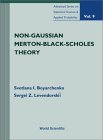
Book Info
Introduces an analytically tractable and computationally effective class of non-Gaussian models for shocks and related analytical methods similar to the initial Merton-Black-Scholes approach.

Book Info
In 1997, the Nobel Prize in Economics was awarded for the work that led to the development of Black-Scholes Options Pricing theory. Black-Scholes has become the dominant way of understanding and exploiting relationships among option prices, stock forecasts, and expected stock market volatility. Now, this accessible book and CD-ROM tutorial provides traders, investors, and finance students with an intuitive, interactive approach to understanding and using the Black-Scholes model.
Integrating text and interactive computer animations and simulations that are presented in a straightforward manner, Option Pricing: Black-Scholes Made Easy teaches you the fundamentals of option valuation and dramatically shortens the learning curve for mastering and applying the theory and its analytic capabilities. Here is a sophisticated way of thinking made available to those who do not have the background necessary to do Nobel Prize-winning mathematics. You will be able to understand easily and intuitively the concepts that drive the Black-Scholes model.
From making it easy for you to see and understand that "every financial forecast is a probability distribution" to tackling myths about options pricing, calculating options' expected returns, and providing a simple, low-risk options strategy, Option Pricing: Black-Scholes Made Easy demystifies this invaluable and profitable tool, shows you your investment odds, and teaches you how to take advantage of them.

Product Description:
Kolmogorov equations are second order parabolic equations with a finite or an infinite number of variables. They are deeply connected with stochastic differential equations in finite or infinite dimensional spaces. They arise in many fields as Mathematical Physics, Chemistry and Mathematical Finance. These equations can be studied both by probabilistic and by analytic methods, using such tools as Gaussian measures, Dirichlet Forms, and stochastic calculus. The following courses have been delivered: N. V. Krylov presented Kolmogorov equations coming from finite-dimensional equations, giving existence, uniqueness and regularity results. M. Rckner has presented an approach to Kolmogorov equations in infinite dimensions, based on an LP-analysis of the corresponding diffusion operators with respect to suitably chosen measures. J. Zabczyk started from classical results of L. Gross, on the heat equation in infinite dimension, and discussed some recent results.
Summary: Index